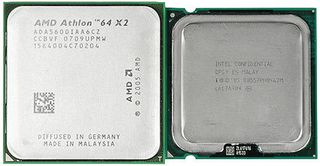Current Mainstream CPU Lineups
Athlon 64 Processors DDR2 Speed Table
While the memory controller is part of the chipset in all Intel desktop systems, AMD has integrated this important component into the CPU, ever since the Athlon 64 family was launched in 2003 (using DDR-1 memory at that time). Going this way adds complexity to the CPU, but also ensures that the memory is as close to the processor as possible. As a result, latencies are shorter, and the memory controller can operate more quickly than a controller that is part of motherboard core logic.
However, the memory controller does not have its own clock generator, but is based on the Athlon's core clock speed instead. As a consequence, the DDR2 memory clock has to be derived from the CPU clock speed, which is achieved by applying an internal memory divider. Depending on the core clock speed, the memory clock speed may not be derived without a remainder, which is the reason that some processors do not run the full memory clock speed. Have a look at the following table:
| Model Number | Frequency | CMOS Technology | L2 Cache | Package | TDP | DDR2 |
|---|---|---|---|---|---|---|
| 6000+ | 3.0 GHz | 90nm SOI | 2 MB | Socket AM2 | 125W | 750 |
| 5600+ | 2.8 GHz | 90nm SOI | 2 MB | Socket AM2 | 89W | 800 |
| 5400+ | 2.8 GHz | 90nm SOI | 1 MB | Socket AM2 | 89W | 800 |
| 5200+ | 2.6 GHz | 90nm SOI | 2 MB | Socket AM2 | 89W 65W | 742 |
| 5000+ | 2.6 GHz | 90nm SOI | 1 MB | Socket AM2 | 89W 65W | 742 |
| 5000+ | 2.6 GHz | 65nm SOI | 1 MB | Socket AM2 | 65W | 742 |
| 4800+ | 2.5 GHz | 65nm SOI | 1 MB | Socket AM2 | 65W | 714 |
| 4600+ | 2.4 GHz | 90nm SOI | 1 MB | Socket AM2 | 89W 65W | 800 |
| 4400+ | 2.3 GHz | 65nm SOI | 1 MB | Socket AM2 | 65W | 767 |
| 4200+ | 2.2 GHz | 90nm SOI | 1 MB | Socket AM2 | 89W 65W | 733 |
| 4000+ | 2.1 GHz | 65nm SOI | 1 MB | Socket AM2 | 65W | 700 |
| 3800+ | 2.0 GHz | 90nm SOI | 1 MB | Socket AM2 | 89W 65W 35W | 800 |
| 3600+ | 1.9 GHz | 65nm SOI | 1 MB | Socket AM2 | 65W | 760 |
For example, the Athlon 64 X2 6000+ runs at a core clock speed of 3.0 GHz. If you wanted to run DDR2-800 memory on your 6000+ system (400 MHz memory interface speed), you'd divide the 3,000 MHz by 400 MHz, which results in 7.5. Since there are no odd memory dividers, the system will automatically use 8, which means that the memory is operated at 3,000 MHz / 8 = 375 MHz, or DDR2-750. The divider 7 cannot be used, as it would result in a base clock speed of 429 MHz or DDR2-858. This is beyond the specification for DDR2-800 and thus will always be rejected, unless you manually overclock the memory.
As you can see in the table above, only a few processors can be recommended with regards to memory speed: all versions running at 2.8, 2.4 or 2.0 GHz will achieve the full DDR2-800 speed, while other models have to live with slower memory clock speeds. The difference isn't really noticeable at everyday workloads, but memory-intensive benchmarks such as WinRAR (file compression/decompression) show quite an impact. The difference can be large enough to neutralize the performance benefit of an additional 200 MHz core clock speed, as you can see when comparing the results of the 5600+ and the 6000+ models in the benchmark section later in this article.
Test Platforms: MSI Motherboards With Integrated Graphics

We used two MSI motherboards that were handy for this test. We already had the Q965MDO from our review of Intel's vPro technology, and the K8AGM2 is one of the first AMD 690 motherboards that we received. Both are based on current chipsets that run with integrated graphics. Using a discrete graphics card would increase the energy demand and bring the power consumption results closer together, which we wanted to avoid. Yes, you can argue that we could have determined the power requirements of the integrated graphics units, but at the end of the day, AMD 590 or an nForce chipset with integrated chipset and Intel's G965/Q965 are the most interesting chipset choices anyway.


Stay on the Cutting Edge
Join the experts who read Tom's Hardware for the inside track on enthusiast PC tech news — and have for over 25 years. We'll send breaking news and in-depth reviews of CPUs, GPUs, AI, maker hardware and more straight to your inbox.
Current page: Athlon 64 Processors DDR2 Speed Table
Prev Page The Challenger: AMD Athlon 64 X2 Next Page Test SetupMost Popular

